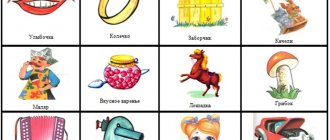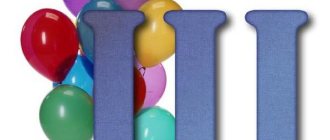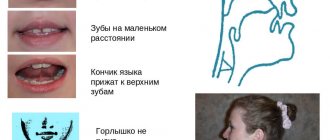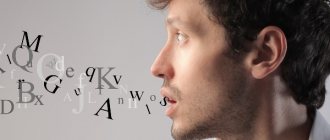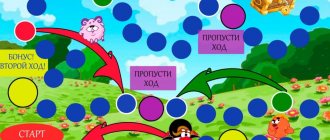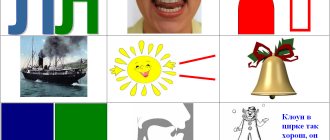Clear and understandable speech is one of the indicators of a child’s successful development. Children who can speak correctly always stand out from their peers. But preschoolers do not always manage to pronounce some letters correctly. The letters R, L, Zh, Sh, S are especially difficult to pronounce.
By what age should children be able to pronounce them correctly? How do you know if you should see a speech therapist? Is it possible to teach a child to pronounce difficult letters on his own? These questions can be answered in this article.
There are also articulation exercises, games and tongue twisters that will definitely come in handy for home training. They will help strengthen your child’s skill in correctly pronouncing such complex letters as R, L, Zh, Sh, S.
A small digression. Sound or letter?
Sound and letter are inseparable from each other. But often even adults confuse these concepts, not understanding the difference between them.
In fact, everything is very simple. What we speak and hear are the sounds of the Russian language. And what we see and read in a book, notebook, computer monitor are letters.
Children first learn to reproduce sounds (speak) and only then begin to write letters (denote what is said graphically).
But due to the fact that we are almost always asked the question: “How to teach a child to say the letter R or the letter Sh?”, we believe that the difference between the letter and the sound in this case is not fundamental. For ease of understanding and reading the article, we chose a single and The term “letter” is familiar to most readers.
How to teach a 3-4 year old child to pronounce the whistling sounds S and Z correctly? Video
If a child is good at articulatory gymnastics movements, then, as a rule, a few simple techniques will allow him to almost immediately learn how to correctly pronounce the whistling sounds s and z. You will learn how you can teach your child at home to correctly pronounce the sound s and correct its pronunciation from Irina Denisova’s video. She shares some professional speech therapy secrets with her parents.
If you managed to successfully evoke a sound, then all that remains is to automate its correct pronunciation in syllables, words and phrases. You can learn about games and exercises for automating the sounds C and Сь in a child’s speech in the article
"Automation of whistling sounds С and Сь"
If a child’s pronunciation of many sounds is impaired, he finds it very difficult to do articulation exercises, and cannot produce the “correct” sound, then you definitely need to contact a speech therapist at a children’s clinic or speech therapy kindergarten. You can always find out the addresses of all institutions where you can get help from a speech therapist free of charge from your district or city education department.
And at the end of the article there are several songs for speech lessons with children based on the sound s.
What Causes Mispronunciation?
There are several reasons that influence incorrect pronunciation.
These include:
- Defects of the organs of the articulatory apparatus
- incorrect structure of the dentition,
- wrong bite,
- the palate is too high or too low,
- short hypoglossal ligament,
- inactive upper lip
- too big or too small tongue.
- Physiological
- insufficient mobility of the organs of the articulatory apparatus (for example, inability to hold the tongue in a certain position when pronouncing sounds),
- general physical weakness during the period of active speech development,
- hearing loss,
- inability to distinguish sounds that are similar in sound ({s}-{sh}, {b}-{p}, etc.)
- Pedagogical
Children are prone to imitation, so authoritative adults and peers should, if possible, have clear speech. You can’t set the wrong example: lisp, sound like a child’s pronunciation. It is important to pronounce all the sounds in a word and articulate it clearly.
At what age should a child pronounce the letters R, L, Zh, Sh, S
Speech therapists say that the formation of sounds occurs in children at approximately the same time. Children should be able to pronounce the letters S, Ш, Ж at the age of 4.
The most difficult ones to pronounce, R and L, appear later in children’s speech. But normally, a child should master P by the age of 6 years. A little earlier he should pronounce the hard letter L.
Second phase. Sound production.
At the second stage, those children who correctly pronounce the sound s clarify its articulation and pronunciation, and consolidate their skills. The same children who did not know how to pronounce it learn to pronounce this sound - “whistle”. It is very important that the child is aware of the correct articulation of sound and can check himself. This is possible from the age of 4. And in classes on speech development, all children are taught this (at least, they should be taught even in the most ordinary kindergarten). Why do children with good sound pronunciation need this knowledge and skills? To develop their ability to consciously control the organs of the articulatory apparatus, to clarify and consolidate correct pronunciation, for clearer and faster operation of the articulatory organs, for good mobility of the organs of the articulatory apparatus. All these skills develop gradually and require training.
At the age of 4, a child learns how teeth, lips, and tongue work when pronouncing sounds in the form of a fairy tale - the game “Tales of the Merry Tongue.”
From the age of 5 , you can explain to children the correct articulation of sound in the form we are familiar with (without a fairy tale) and ask the child questions: “How does the mouth work? What does the tongue do”, etc. In older preschool age, it is already important not only to make a movement and be able to talk about the correct execution of the exercise, but also to monitor the smoothness and accuracy of the movements, the quick switching to a new movement, and the ease of movements.
Articulatory gymnastics with children of any age can be completed with an exercise or game with onomatopoeia with a given sound, which you will find below.
When producing a sound, the baby also learns the correct articulation of the sound.
Correct articulation of sound p.
When correctly pronouncing a sound with: • The mouth smiles (the corners of the mouth are slightly drawn back), • The teeth are closed, • The tip of the tongue rests on the lower incisors (i.e., it is located below, not at the top), • The anterior part of the back of the tongue is close to the alveoli and forms a gap with them (children know the alveoli as “tubercles” on the palate, at the top of the mouth), • In the middle of the tongue, when pronouncing a sound, a groove is formed through which air flows. • Unlike hissing sounds, when making whistling sounds the air stream is cold ! In order to determine which stream of air is coming from the mouth, you need to bring your hand to your mouth, palm down. Pronounce the sound Ш yourself in this position, and then the sound S, and you will see the difference. You can show your baby this difference by blowing on his hand while pronouncing these two sounds. And then he himself will be happy to experiment to see how it works out for him - a cold stream of air or not.
For four-year-old children, you can practice the sound C in the form of a game. Invite your child to ride a bike. To do this, we need to inflate the tires that are slightly deflated with air. We will work with the pump and inflate the tires with air: sssss. Show yourself how the “pump works” - sss (show the articulation of this sound so that the child can clearly see your face). Ask your child: what is the position of the lips when the pump whistles? (In a smile). Are teeth visible? (Yes). Where is the tip of the tongue? (Below, hidden behind his lower teeth). What kind of air is coming in - cool or hot? (Cool) – bring the back of your hand to your mouth. Compare with the sound X - is the air warmer with the sound X or the sound of the pump C? Invite your child to “take the pump” (pantomime - an imaginary action) and “pump up the tires” - whistle ssss. Very often, even such clarification of the correct sound pronunciation of the sound C in the game “Pump” is enough for a four-year-old child to begin to pronounce the sound correctly!
It happens that “playing the pump” is not enough and you need to clarify the articulation of sound individually, in front of a mirror. When making a sound by imitation, you can invite the baby to blow on his slightly protruding wide tongue, imitating you. After this, you need to move your tongue behind your lower teeth. “Look where my tongue is. Do you see the teeth? Do the same. Smile so your teeth are visible. Press your wide tongue against your front teeth at the top. Well done! Now cover your mouth and let's blow. Raise your hand to your chin – can you feel the air flowing?” Place the cotton wool on the child's chin so that a stream of air hits it. If the child blows weakly, then ask him to blow harder, but do not puff out his cheeks. So, by imitation, the child will get the correct sound s. Repeat this sound 5-6 times with pauses.
You should not expect that the sound C, which appears through imitation, will immediately appear in the child’s speech. For a child, this is just the sound of a pump in a game! Even the next day, the baby may already forget everything, and you will have to demonstrate the sound production exercise again. And ask him to whistle like a pump, make noise like a vacuum cleaner, blow and whistle like the wind, etc. In order for the sound to enter the child’s speech, games and play exercises are needed to automate it, which I will talk about in the next article. After all, just repeating words and phrases with sound is not at all interesting for a baby! You also need to teach the child to distinguish sounds that are close and similar to each other, so as not to confuse them in speech. We will also talk about this in the continuation of this article.
And at the end, I want to offer you two videos about making whistling sounds with a demonstration of simple and accessible techniques.
How to conduct speech therapy sessions with your child at home. Adviсe
Classes should be held in a playful way. This way the child will not be wary of them, nervous or complex.
- You cannot overly insist on exercises and force your child. Classes should bring him pleasure. Only in this case will your pronunciation quickly begin to improve.
- The lesson should not exceed 15 minutes, and articulation gymnastics (warm-up) should last at least 5 minutes. This is how the exercises will bring the greatest benefit.
- You should not repeat breathing and voice exercises more than 4-5 times. Children tire quickly, use more oxygen than usual, and may feel dizzy.
- The child should not have a cold (stuffy nose, sore throat), otherwise breathing exercises will be performed incorrectly and will not be beneficial.
- To enhance the effect of classes, it is necessary to consolidate skills throughout the day. Children will have fun playing and saying tongue twisters together with adults. You can do this both at home and on a walk.
- You can invite your child to act as a teacher. Let him “teach” his favorite toy to pronounce a letter.
- Games and exercises for fine motor skills - modeling, coloring, designing letters - will help develop speech.
- Be sure to praise your baby. It is important for him to feel his achievements.
What exactly are we developing?
First of all, of course, a passive dictionary. But it is not only he who contributes to the development of pronunciation skills. Thus, it has long been proven that the brain centers responsible for the development of fine motor skills and speech are located nearby and influence each other. Therefore, in order to ensure that the baby does not have problems with speech, it is important to pay attention to the development of fine motor skills. These could be activities such as:
- finger exercises or finger massage (at a very early age);
- sorting through cereals, small buttons, nuts;
- lacing, fastening zippers, buttons;
- screwing caps on bottles;
- finger painting on sand, semolina, flour;
- painting, modeling;
- stringing large beads on a string.
And in order for the speech apparatus to be in good shape, it needs to be constantly trained. For this purpose, special articulation gymnastics complexes have been developed. They help the child’s lips, tongue, jaws, and cheeks acquire the necessary strength, tone, mobility and controllability, learn the correct force and direction of air supply when speaking, and make speech rhythmic and beautiful. Only the correct functioning of these organs will help the baby master the necessary pronunciation. We talked about articulatory gymnastics in detail in this article.
When starting any classes with a preschooler, remember that they should last no more than 15 minutes. Pay attention to the baby's mood and willingness to accept the game. If he doesn’t want to, don’t insist, don’t force (especially don’t promise “heavenly punishment”!). Otherwise, having once felt such an attitude, the child may lose interest in any learning for the rest of his life or even begin to hate it.
Letter P
Incorrect pronunciation of the letter P is quite common.
If you do not work on your pronunciation, this defect can remain for life. There are several options for incorrect pronunciation of the letter R:
- children may not pronounce this sound at all (cow - koova),
- there may be a replacement of the hard letter P with a soft one (hand - ryuka),
- sometimes the letter P is replaced by other letters (ruka-luka, duka, luka, yuka, etc.).
How to work with a child to teach him how to correctly pronounce the letter R?
- Articulation exercises will prepare the muscles of the lips and tongue for exercise. They need to be done daily.
- "Jam". The child should open his mouth slightly and move his tongue left and right along his upper lip. To interest your baby, you can put something sweet in your mouth.
- "Painter". You need to move your tongue back and forth across the roof of your mouth, just like a painter does with his brush.
- "Mushroom". The child needs to open his mouth, smile and press his tongue completely to the palate, holding it for 3 to 10 counts.
- Breathing exercises will help you direct the air stream with the right intensity to get the right sound. Inhalation should be strictly through the nose, and exhale through the mouth. There is no need to repeat the exercise more than 4 times.
- "Candle". You need to blow out the burning candle. This can be done with a short, strong stream of air, or, on the contrary, with a weak one. Or blow it from close range, increasing the distance each time.
- "Snowflake". The child should stretch his lips in a smile and place his tongue on the lower lip. You need to blow off a piece of paper (“snowflake”) on the tip of your tongue.
- "Storm". You will need a glass of water and a straw. The child needs to exhale into a tube lowered into a glass. This will create a real “storm” in the water.
- Vibration with the tongue - learning to feel and reproduce.
You need to sit down with your child in front of the mirror. He should see the position of the adult's tongue and lips. This will make it easier to repeat the correct sound. It’s worth trying to pronounce the letter R by roaring like a tiger or purring like a cat. The exercises will be more effective if the child is interested in completing the tasks.
You can learn to pronounce the letter R using other letters. For example, a child can pronounce the sound Z in a drawn-out manner while holding his tongue in the upper position. Then you need to quickly run your tongue along the tubercles behind the upper jaw. The sound will be SR.
You can also work with other letters. For example, learning to pronounce R through well-practiced D, F, S. Gradually, you will be able to get rid of unnecessary letters by automating the pronunciation of the letter R. To do this, you need to often use words in your speech that contain the problematic letter R.
Games with the letter R
To consolidate the effect of the exercises, it is important to return to practicing skills throughout the day.
- "Magic bag" Children take out objects or pictures with images of objects from the bag. You must pronounce the name of the object, clearly pronouncing the letter R.
- Games with cereals. They stimulate fine motor skills well, and therefore speech. You can depict objects whose names contain the letter R. For example, the crown from the grRRRRRiver.
- Repeat the syllable in reverse. Ar-ra, ur-ru, etc.
- Finish the sentence. You will need pictures with hints. For example, ro-ro-ro - feather.
- Short songs or poems. For example:
Lamb, lamb, show me your horns. I'll give you sugar, a piece of pie!
Tongue twisters with the letter P
- The red crab shouts "Hurray!" It's time to cut the cake.
- The crow missed the little crow.
- Karl stole corals from Clara, and Clara stole a clarinet from Karl.
- There is grass in the yard, there is firewood on the grass. Don't cut wood on the grass in your yard.
- Three magpies chattered on the slide.
- The angry crocodile is irritated and unsociable.
- Thunder struck - a thunderstorm was in full swing.
- Borya gave Ira Toffee. Ira Bore - barberry.
- Thirty-three trumpeters sound the alarm.
Letter Ш
In order for the letter Ш to be pronounced correctly, the speech apparatus must be well trained.
When pronouncing the letter Ш correctly, the tongue is positioned strictly symmetrically. The lips are always rounded, and the teeth are as close to each other as possible. In the middle of the wide tongue there is a warm stream of air, which can be easily felt with the palm of your hand near the mouth. Vocal cords are open.
It is often difficult for children to perform such actions with their tongue and lips. Therefore, there are various ways to pronounce the letter Sh.
Attention! None of the following pronunciations are correct. They all require adjustments.
- interdental pronunciation (the sound in this case is lisping, and the tongue is stuck between the teeth),
- pronouncing "in the nose"
- a way in which the tongue rests on the teeth, and the sound becomes similar to T,
- when there is a malocclusion, the sound is similar to F,
- sound reminiscent of S.
You can learn to pronounce the letter Ш at home. To do this, you need to perform exercises daily to establish breathing and train the muscles of the tongue and lips.
In addition, you must complete game tasks to consolidate the skills you have learned.
Articulatory gymnastics is performed daily, at the beginning of the lesson. It is important to stretch not only your tongue, but also your lips.
- Tongue exercises:
- “Hide the candy.” The child should keep his wide tongue on his lower lip. An adult places a small piece of marshmallow or marshmallow on its edge. The baby needs to hide a piece of sweetness by holding it with his tongue behind his upper teeth and sticking it to the roof of his mouth. The exercise is performed at a slow pace. The mouth should not open wider than 2 cm.
- "Football". You need to smile and put your wide tongue on your lower lip. Before this, you need to prepare a piece of cotton wool. The child should blow on the cotton wool, pronouncing the sound F. You need to roll it to the opposite end of the table. It is important to ensure that the sound is pronounced as F, not X - this will affect the width of the air stream. The cheeks should not puff out.
- "Harmonic". You need to smile, stick your tongue to the roof of your mouth, and, without letting go of your tongue, open and close your mouth. Worth imagining. that this is accordion fur. Each time you need to open your mouth wider and wider, and hold your tongue in position at the palate longer (from 3 to 10 counts). The sides of the tongue should not sag. The mouth and lips are always motionless.
- Lip exercises:
- "Tube". The child should stretch out his lips with a straw and silently pronounce the letter U.
- "Bunny." You need to smile, opening your upper and lower teeth. The upper and lower lips rise in turn. It is important to ensure that the teeth are closed and the lips return to their original position.
Games with the letter Ш
- Finish the phrase (or repeat it). It is worth preparing pictures in advance to help. For example:
Shu-shu-shu - Masha eats noodles. Shi-shi-shi - eat your porridge, kids. Sho-sho-sho - Pasha writes well.
- Game "Change the word." We need to change the word so that the sound “sh” appears in it. At first, you may need the help of an adult. But soon the child will be able to change words according to the model on his own.
Peas - peas, nut - nut, sparrow - sparrow, bread - bread, etc.
- Hiss like a snake, like a deflated balloon, etc.
- Songs, nursery rhymes, poems.
Letter Ш - Hissing, Sometimes-Rustling, Often-Rustling, Occasionally-Grindling.
The snake hisses, hisses, hisses, has been learning the alphabet for six months, the poor thing is already tired, and only knows the letter - Sh-Sh-She.
Shu-shu-shu - the mouse rustled, Shu-shu-shu - the reeds rustled, The nimble little woodpecker, Husking the sixth cone. What's that noise? Ears can hear, Someone is breathing louder, louder, Someone is waving higher, higher, Someone is whispering: “Hush, hush.”
Tongue twisters with the letter Sh
A good way to reinforce the learned skill of pronouncing the letter Sh in a fun way is to learn funny tongue twisters.
- The mouse sewed boots for the cat, and the cat sewed pants for the mouse.
- Shura sewed boots with an awl for a chinchilla in a hut.
- Our sail is sewn conscientiously, even a storm will not frighten us.
- The sperm whale does not like porridge; porridge makes him cough.
- Piggy Nyusha invited the mouse Masha to eat porridge. Masha the mouse brought Nyusha the pig a piece of pear.
- Pasha Sasha sews boots, and Sasha Pasha bakes pies.
- They sewed a shirt with pockets, sewed it, sewed it, altered it, sewed it up, but didn’t embroider it.
Letter Z
Learning to pronounce the letter Z will be easy if the child already knows how to say the letter Sh. The fact is that the movements of the tongue and lips when pronouncing them are almost the same. Only when pronouncing the letter Z are the vocal cords still actively activated.
This difference is easy to notice even for a child. Let him place his palm on the throat of an adult who pronounces the letters Ш and Ж in turn. The child will feel how the vocal cords vibrate when they say the letter Ж. When pronouncing the letter Ш, they will remain motionless.
Pay attention to how to pronounce the letter Z correctly. The lips should be rounded and the teeth should be close to each other. The wide tip of the tongue is close to the alveoli (recesses in the bones of the upper jaw), the edges of the tongue are pressed against the lateral teeth, and the back of the tongue is raised and tends back. A warm stream of air passes through the middle of the tongue. The vocal folds are tense and give voice.
Articulation and breathing exercises are suitable for classes. They also develop and prepare the lips, tongue and breathing for pronouncing the letter Z.
Games with the letter Z
- Buzz like a beetle, bee or fly.
- "Bees collect honey." Participants imagine themselves as bees and buzz while spinning and moving around the room. At the signal, you need to “fly away” to the “house” as quickly as possible.
- "Flies in the Web." The game is suitable for a group of children. Some of them depict a web, forming a circle. The other part of the children are “flies”; they run in and out of the circle, buzzing as they do so. At the signal, the “web” children join hands, and those “flies” that did not have time to get out of the circle also get into the web. The game lasts until all the flies are caught.
- “Who needs this?” An adult shows the child story pictures with missing objects. Then you need to take out an object picture and ask what is depicted on it (objects whose names contain the letter Z). For example, a picture of scissors. The child says the name out loud and decides which story picture lacks scissors. For example, grandma needs them to sew.
Tongue twisters with the letter Z
- Zhenya and Vika are chewing blackberries.
- Hedgehogs and grass snakes lived in the living corner.
- It's hot for a toad in a warm puddle. The toad waits for the rain and grieves.
- What do hedgehogs have for dinner? Acorn peel.
- The snake has a bite, the hedgehog has a hedgehog.
- Little Matryoshka's earrings have disappeared. Earrings I found an earring on the path.
- The hedgehog is lying by the Christmas tree, the hedgehog has needles.
- On the roof of Shura lived the crane Zhura. The crane Zhura lived on the roof of Shura.
Letter L
This is one of the most difficult letters to pronounce. Children learn to pronounce it one of the last. However, it is important to start working on correct pronunciation as early as possible.
How to pronounce the letter L correctly?
The lips stretch into a smile, and the teeth are clenched. The tongue can rest against the teeth, the gap between the upper and lower teeth, or the alveoli. The sides of the tongue do not interfere with the free passage of the air stream.
There are several options for incorrectly pronouncing the letter L.
- complete absence of this sound (spoon-spoon)
- replacing with a simpler sound, for example, U
- distorted pronunciation (similar to S, J or R)
- inability to distinguish between hard and soft L.
It is worth trying the following articulation and breathing exercises :
- «Smile". Keep your lips stretched out in a smile, counting to 10. Your mouth should be closed.
- «Locomotive". The lips stretch into a smile, the teeth are clenched, the tongue presses on the teeth, like on a locomotive whistle, and adds a voice. This produces the sound L.
- «Dog". The child stretches his lips in a smile, shows his teeth and bites the tip of his tongue. Then you need to start breathing like a hot dog. It is important to ensure that the air passes through the mouth and not through the nose. Then you need to connect your vocal cords and pronounce YYY or AAA. There is no need to puff out your cheeks.
- «Horse." Smiling widely and showing your teeth, you need to click your tongue (as if a horse is galloping). The lower jaw should remain motionless.
- Move your tongue in your mouth alternately to the right and left.
- «The breeze is blowing." The lips stretch into a smile, the mouth opens slightly and the tongue is bitten. The child begins to blow on the cotton wool in the palm of the adult.
- «Pencil". You need to take a deep breath through your nose and exhale a stream of air through your mouth so that you can roll a pencil across the table.
Games with the letter L
- “Say the sentence.” These can be rhyming sentences that you need to come up with yourself (for example, lo-lo-lo - it’s warm outside). The child can also continue the lines of poems known to him (for example, A. Barto “The Little Frogs”).
- "Box of Pictures" Let the child name the objects shown in the pictures (the names of which contain the letter L). Then you need to make a sentence out of these few words. For example: a bowl of raspberries and a lamp are on the table.
- "What's missing?" On the table there are objects whose names contain the letter L (spoon, boat, frog, etc.). For a few seconds, the child turns away from the table, and the adult hides the object. You need to name the “missing” thing.
- Rhymes and songs.
It ran away, it ran away, the milk ran away. I caught it with difficulty, Being a mistress is not easy!
Grandfather planted onions and grew an onion. The grandson saw the bow and tore off the forelock of the bow. An amazing thing: Tears are falling - from the grandson!
Here are the needles and pins crawling out from under the bench. They look at me, they want milk.
Tongue twisters with the letter L
- Lena was looking for a pin, and the pin fell under the bench.
- On the river shallows we came across a burbot.
- There is no ring near the well.
- The Queen gave the gentleman a caravel.
- Our Polkan from Baikal lapped. Lakal, lakal, but Baikal did not become shallow.
- Mom washed Mila with soap.
- Antipas had one linden tree, but Philip planted seven linden trees.
- Crucian carp, don't get into the hole! A crucian carp got stuck in a hole.
- Karl was putting the onion on the chest. Clara was stealing onions from the chest.
Letter C
Incorrect pronunciation of the letter C in children is quite common. Options for incorrect pronunciation of C are :
- there is no sound at all (juice - ok),
- it is replaced by something easier to pronounce (dog - shabaka, etc.)
- The child confuses hard and soft C (dog - shabaka).
Pronouncing the letter C requires trained tongue and lip muscles, as well as proper breathing.
The lips smile slightly, the upper and lower incisors are visible. The teeth are almost closed. The wide tip of the tongue touches the lower front teeth. The lateral edges of the tongue meet the lateral teeth of the upper jaw. The back of the tongue and the alveoli form a narrow gap for the exit of a strong and cold air stream. The vocal cords are open and do not produce vocal vibration.
Articulation and breathing exercises will help train a child’s speech apparatus
Exercises should be alternated with each other and performed at a measured count.
- “Whistling” - with clenched teeth, you need to stretch out your lips with a tube, as when whistling.
- “Smile” - the lips stretch into a smile, but the teeth remain open.
- “Brushing your teeth” - you need to open your lips and run the tip of your tongue over your teeth (from right to left and back, on the upper and lower jaw).
- “Watch” - the lips smile, and the tip of the tongue moves alternately to the right and left corners of the mouth. The lower jaw should be motionless.
- “Swing” - the child should try to reach the tip of the nose, the chin, the upper and lower lips, the space between the teeth and the lips of the upper and lower jaw with his tongue. The tongue always remains wide, and the lips do not cover the teeth.
Games with the letter C
- Continue with pure sayings (or even come up with your own using pictures). Sa-sa-sa - a wasp is flying around the yard. Su-su-su - it’s good in the forest now.
- Songs, poems, nursery rhymes.
Nice uncle - Elephant, he loves to listen to fairy tales. Fairy tales are mischievous, the funniest.
The sun is shining clearly - Everything is fine with us! The sun hid behind the forest, the moon is shining... with the letter S.
The magpies are at the magpie Urgently doing their homework: One hundred and forty magpies are scribbling lines merrily.
- Lotto (pictures and cards with images of objects whose names contain the letter C). We take out a picture, say the word, put it on a card with its image. Whoever collects the full set of pictures the fastest wins.
- Come up with a sentence with words. Adults need to prepare pictures in advance (they can show a clock, a dryer, an icicle, a sausage, a braid, etc.)
- Puzzles. Of course, the answer must contain the letter C.
Here is a mountain, and near the mountain there are two deep holes. The air wanders in these holes: It comes in and then comes out. (Nose)
There is a white nail growing under our very roof, but as the sun rises, the nail will melt and fall. (Icicle)
A white blanket lay on the ground, Summer came - it was all gone. (Snow)
- Remember words starting with the letter C. You need to pronounce them one by one. The one who knows more words wins.
- Finger games, nursery rhymes (Finger Boy, White-sided Magpie, etc.)
Tongue twisters with the letter C
- Senya carries hay in the canopy. Senya will sleep on the hay.
- The wasp does not have whiskers, not whiskers, but antennae.
- Senya and Sanya have a catfish with a mustache in their nets.
- Mow, mow, while there is dew. Dew away - and we're home.
- The sunflowers look at the sun, and the sun looks at the sunflowers.
- The cream in the pussy's bowl has turned sour.
- Pussy ate soup from a bowl. The bowl is empty, the pussy is full.
- Millet flying in Frosya's field. Frosya takes out the weeds.
- Sasha is perfection, and also improves herself.
How to test your child’s speech yourself
- When checking a child’s speech, the first thing to check is the pronunciation of the sounds “sh”, “zh”, “ch”, “sch” (a group of hissing sounds), “s”, “s”, “z”, “z”, “ts” (a group of whistling sounds) and “r”, “ry”, “l”, “l” (sonorant sounds).
- During an independent speech test, do not ask your child to repeat words or sounds after you. This method does not give a reliable idea of his independent speech. After all, imitating an adult, a baby often pronounces sounds better than on his own. Invite your child to recite a poem or retell a fairy tale. Listen carefully to his speech, try to determine which sounds he does not pronounce or pronounces incorrectly.
- A more detailed check of which sounds a child cannot pronounce can be done at home without a speech therapist using pictures. Invite your child to name what is drawn in the picture, listen carefully to how your baby pronounces this or that sound. The sound being examined must be in different positions in words (at the beginning, in the middle, at the end of the word).
Here is an approximate list of pictures to independently check your child’s speech and find out what sounds he cannot pronounce:
Sound “s”
- dog, sled, apricots, cabbage, bus
Sound “s”
- 7 (seven), geese, elk
Sound “z” "
- castle, umbrella, goat, vase
Sound "z"
- mirror, zebra, basket
Sound "ts"
- chicken, cucumbers, egg, hare
Sound "sh"
- hat, fur coat, pine cone, pencil
Sound "zh"
- beetle, hedgehog, scissors
Sound “ch”
- teapot, ball, key, turtle, barrel
Sound “sch”
- brush, box, cloak
Sound “l”
- lamp, table, squirrel, chair
Sound “l”
- fox, telephone, salt
Sound “r”
- crayfish, fish, ball, watermelon, zebra, grapes, cheese, tomato
Sound “ry”
- radish, cucumber, mushrooms, gingerbread
Sound “th”
- teapot, sparrow, tram, bench
Usually, a violation of a hard consonant is accompanied by a distortion of its soft version. For example. if the sound “s” is pronounced interdentally, then the sound “s” will also be interdental.
Be sure to check whether the child pronounces the sound being tested incorrectly in all words, and whether he can pronounce the sound in isolation. To do this, invite your child to repeat after you the sound that he does not pronounce in phrasal speech and in individual words. If a child correctly pronounces a sound in an isolated form, then the work of producing the sound is eliminated.
In such cases, you only need to clarify the pronunciation of the sound, and then consolidate it in words and phrases. If the sound is still pronounced distorted, then it is necessary to develop the correct position of the speech organs, in which a clear pronunciation is achieved.
When replacing one sound with another, multi-stage work is carried out. In addition to developing correct pronunciation (sound production) and consolidating it in speech, it is necessary to carry out work to distinguish between the newly received sound and the substitute sound. For example, when replacing the sound “sh” with the sound “s” (cat - “koska”), you need to carry out a series of exercises that will teach the baby to distinguish between the sounds “sh” and “s”.
When to seek help from a speech therapist
You shouldn’t delay going to an appointment with a speech therapist. The sooner work on your baby’s speech begins, the faster he will learn to speak beautifully and clearly. It is necessary to consult a specialist in the following cases:
- At 3-4 years old, a child cannot stretch out his lips like a tube, puff out his cheeks, stick out his tongue, touch the palate with it, or reproduce the simplest rhythm.
- After 3.5 years, the baby skips syllables in words and confuses their places.
- At 4.5 - 5 years old, a preschooler does not speak in coherent phrases and confuses gender, number and case in sentences.
- The child speaks through his nose.
- He chokes on words, unable to keep up with his thoughts.
- The baby swallows the syllables.
- He doesn't have enough breath to pronounce the phrase.
- The child speaks monotonously.
- The preschooler does not strive to communicate and discuss what he saw, heard, etc.
- Homework on incorrect pronunciation of letters does not bring the expected effect.
- The child has congenital anomalies - cleft lip, short ligament on the tongue, decreased hearing, etc.
A child’s correct speech is not formed immediately. There are age standards that determine at what age a child should be able to pronounce a particular letter.
If a child cannot pronounce a certain letter correctly, parents can teach him at home.
Correct pronunciation requires trained muscles of the lips and tongue, as well as proper breathing. Articulation and breathing exercises, as well as games and tongue twisters to consolidate the acquired skill, will help teach your child to pronounce letters correctly.
It is imperative to encourage and praise your child for his successes. Seeing the support of adults and the effect of the work done, the child will enjoy the classes. And this is the key to a good result. This way the baby will learn to correctly pronounce even such complex letters as R, Ш, Ж, Л, С.
If you liked the article, please share a link to it
Speech development and parental involvement
So what is parental help? First of all, it is important for adults to understand that it is impossible to simply teach a child to say letters. This process is long, systematic and comprehensive. Children’s speech develops along with the improvement of other skills: both psychomotor and physical. If the baby is behind in development (he started holding his head up late, sitting up, he has problems with memory, attention) - speech will most likely also lag behind.
What needs to be done to ensure that everything happens on time? Firstly, monitor overall development - train muscles, dexterity, motor skills, memory, attention.
The following aspects are especially important for developing speech skills.
- From a very early age, parents should speak to the child clearly and correctly: without childish touching “lisping”, without adjusting words to the child’s age. Yes, a baby can speak incorrectly due to age-related imperfections of his speech apparatus. But he should hear only accurate speech around him: correct, clear, literate, without verbal garbage (“well this”, “damn”, “in short”, “what”), otherwise the incorrect pronunciation will become fixed in his speech and then these problems will arise adjust with specialists. And this is much more difficult.
- The process cannot be left to chance. With such a passive approach, the baby will certainly begin to lag behind. Teaching him the correct pronunciation is just as important as teaching him to hold a spoon or pull on tights.
- There should always be an active speech environment around the child. He must hear speech all the time. You need to comment on all actions, talk about everything that is happening, and name all the surrounding objects. Then the child from an early age will not only enrich his passive vocabulary, but also understand the importance of speech for communication.
